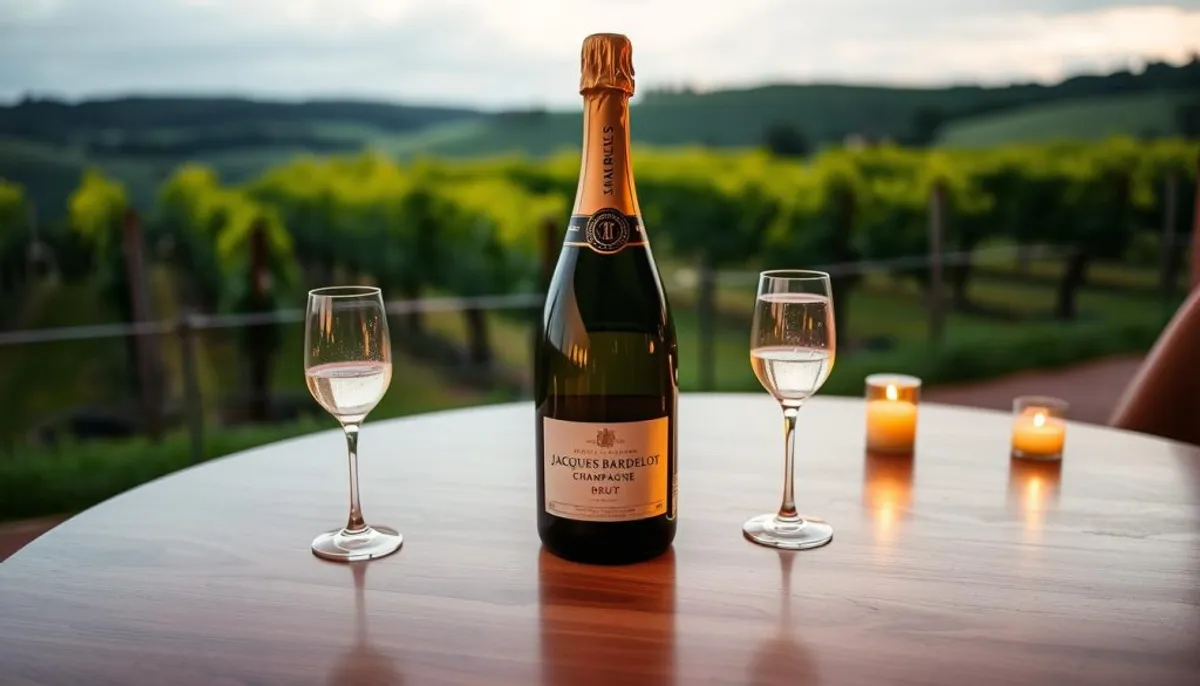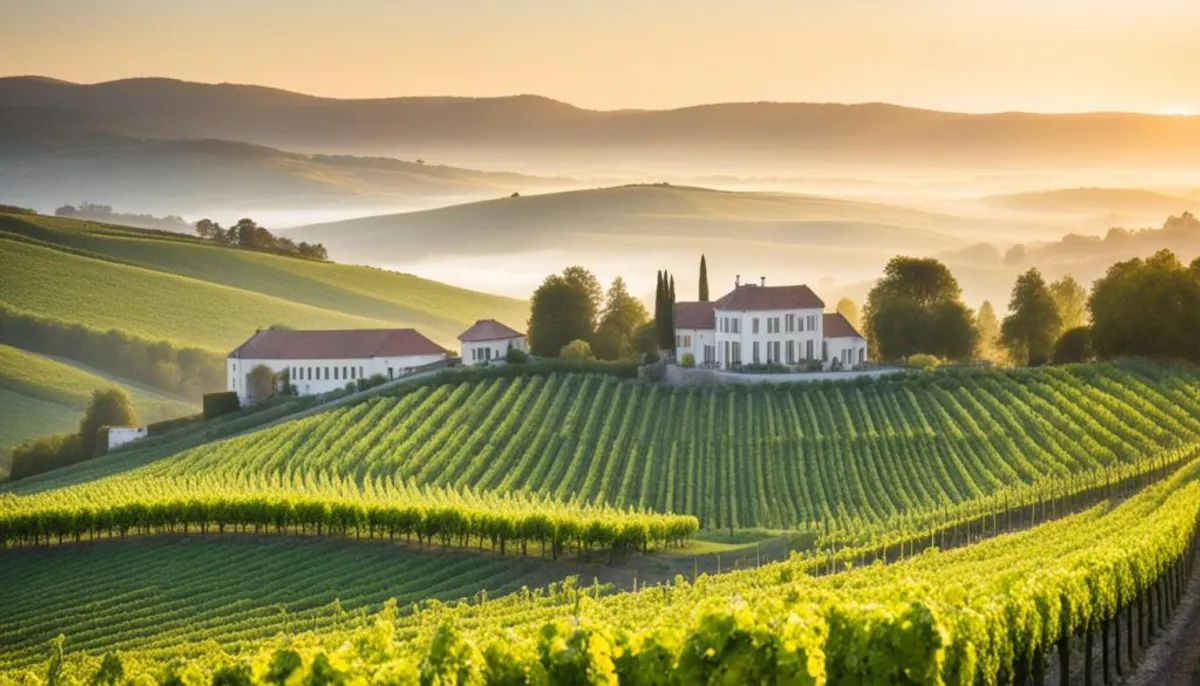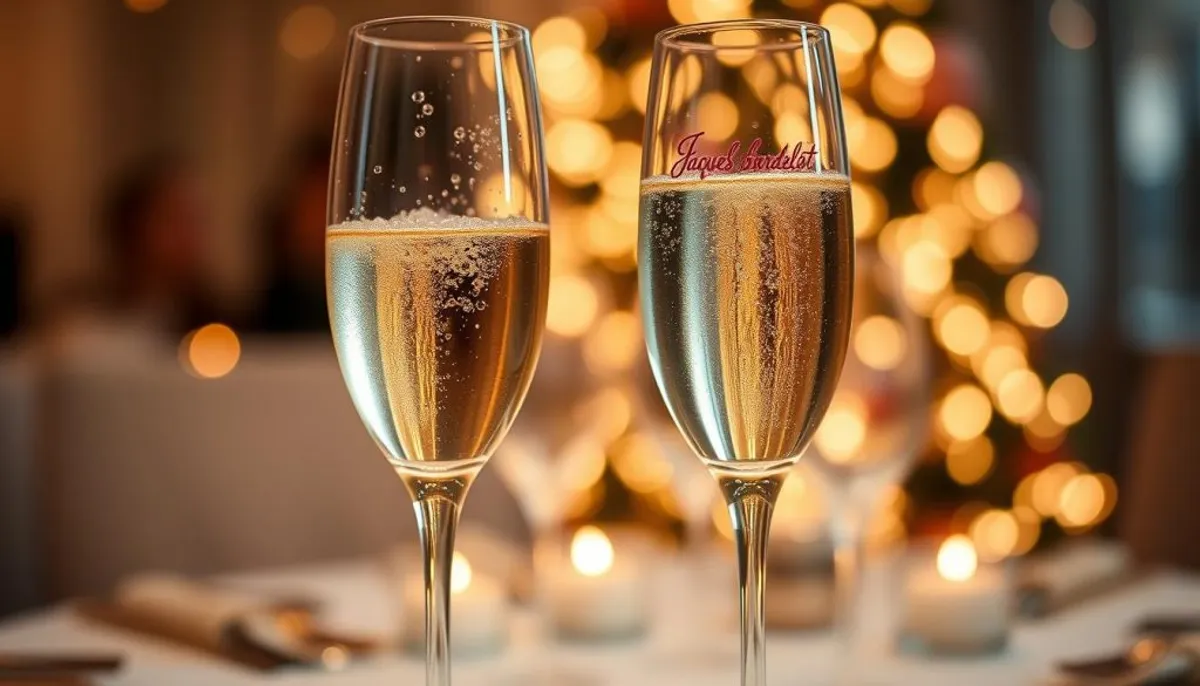Envision yourself savoring a glass of exquisite French Champagne, its fine bubbles caressing your palate. This is the sensation Jacques Bardelot Champagne Brut offers at your celebrations. Originating from the celebrated Champagne region, its winemaking heritage stretches back to the early 17th century.
With meticulous craftsmanship, Jacques Bardelot Champagne Brut is a blend of Pinot Noir, Chardonnay, and Pinot Meunier grapes. The outcome is a luxurious drink that harmonizes elegance with zesty citrus and green apple flavors, complemented by subtle brioche undertones.

This French Champagne is distinguished by its lively acidity and medium body. It serves as an excellent choice for an aperitif or when paired with seafood and soft cheeses. Whether celebrating a significant event or simply enjoying life’s pleasures, Jacques Bardelot provides a taste of genuine Champagne opulence.
Key Takeaways
- Jacques Bardelot is an authentic French Champagne from the historic Champagne region
- Crafted using traditional methods, including second fermentation in the bottle
- Offers a balanced flavor profile with notes of citrus, green apple, and brioche
- Ideal for celebrations or as an aperitif
- Pairs well with seafood, poultry, and soft cheeses
- Free delivery available for orders over £140
- Expertly rated for its dry sweetness and vibrant acidity
The Heritage of Champagne: From Roman Vineyards to Modern Luxury
The journey through Champagne’s history is nothing short of captivating. It commences with the establishment of Roman vineyards and culminates in its status as a luxury and celebratory icon. The narrative of this sparkling wine is as intricate and flavorful as its taste itself.
Roman Origins in Reims
In the 5th century, the Romans planted the first vineyards in Reims, laying the groundwork for Champagne’s global acclaim. The region’s chalky soil and distinct climate proved perfect for grape cultivation. This early endeavor set the stage for what would become a renowned wine-producing area.
Evolution into a Luxury Beverage
The metamorphosis of Champagne into a luxury wine spanned centuries. Initially, the region was known for its still wines. The advent of bubbles in the 19th century marked a significant turning point. The first sparkling Champagne was crafted in 1836, ushering in a new chapter in winemaking. Since then, Champagne has epitomized celebration and elegance.
The Protected Champagne Appellation
The Champagne appellation is instrumental in safeguarding the wine’s heritage and quality. Only wines produced within the Champagne region of France can be labeled as such. This stringent rule guarantees the authenticity and superiority of every bottle, solidifying Champagne’s reputation as a quintessential luxury wine.
| Year | Milestone |
|---|---|
| 5th Century | Romans establish vineyards in Reims |
| 1836 | First sparkling Champagne produced |
| Present Day | Protected Champagne appellation |
Understanding Jacques Bardelot Champagne Brut
Jacques Bardelot Champagne Brut exemplifies the pinnacle of French sparkling wines. This non-vintage Brut Champagne is a quintessential representation of the Champagne style. It is crafted from grapes sourced from the esteemed Champagne region. Its consistent quality has earned it a loyal following among wine aficionados.
The wine characteristics of Jacques Bardelot Brut are marked by a dry profile and vibrant acidity. Its medium body and mildly aromatic intensity contribute to a balanced and refreshing taste. The absence of tannins ensures a smooth texture, making it perfect for various occasions.
Let’s take a closer look at the key features of Jacques Bardelot Champagne Brut:
| Feature | Description |
|---|---|
| Type | Non-vintage sparkling wine |
| Origin | Champagne region, France |
| Style | Brut (dry) |
| Body | Medium |
| Acidity | Vibrant |
| Tannins | None |
| Aromatic Intensity | Mild |
| Alcohol Content | Moderate |
The meticulous selection of grapes from premier vineyards is key to Jacques Bardelot Brut’s unique character. This dedication to grape selection and winemaking ensures a Champagne that consistently pleases the palate. It is a preferred choice for both celebratory moments and refined dining experiences.
The Distinguished Terroir of Champagne Region
The Champagne terroir is a unique amalgamation of natural elements, creating an ideal environment for exceptional sparkling wines. This region is characterized by chalky soils, a distinct microclimate, and specific vineyard features. These elements contribute to the creation of world-renowned champagnes.
Chalky Soil Characteristics
The chalky soils of Champagne are crucial for the wine’s character. These limestone-rich grounds ensure excellent drainage and reflect sunlight, aiding in grape ripening. The chalk imparts a subtle mineral quality, enhancing the wines’ complexity and flavor profile.
Unique Microclimate Effects
Champagne’s microclimate is marked by cool temperatures and moderate rainfall. This climate slows grape ripening, allowing for the development of delicate flavors and high acidity. These are key components in creating the region’s signature sparkling wines. The interplay between temperature and humidity creates ideal conditions for growing the primary Champagne grape varieties.

Regional Growing Conditions
The vineyard features in Champagne are meticulously managed to maximize quality. Growers employ specific pruning techniques and canopy management to control yields and ensure optimal grape ripeness. These practices, combined with the region’s unique soil and climate, create the perfect environment for producing grapes for exceptional Champagne.
The Champagne region’s distinct terroir, with its chalky soils, unique microclimate, and carefully tended vineyard features, is essential for its world-famous sparkling wines. This special combination of factors contributes to the creation of champagnes with unparalleled depth, complexity, and finesse.
The Art of Traditional Champagne Making
Champagne production is a centuries-old craft, deeply rooted in the Champagne region. This area, home to over 16,000 growers and 320 Champagne houses, is the origin of this renowned sparkling wine. The creation of Jacques Bardelot Champagne Brut exemplifies this tradition, requiring meticulous care and patience.
Second Fermentation Process
The essence of Champagne is its second fermentation. Following the first fermentation, the wine is combined with sugar and yeast, known as the liqueur de tirage. This mixture initiates a second fermentation within the bottle. It produces carbon dioxide, which dissolves into the wine, creating the distinctive bubbles.
Fine Bubble Development
The formation of fine bubbles is critical in Champagne production. These small bubbles, generated during the second fermentation, significantly impact the wine’s texture and mouthfeel. The longer the wine ages on the lees, the finer and more enduring the bubbles become.
Aging and Maturation
Aging is essential in the production of Champagne. Jacques Bardelot Champagne Brut is aged extensively on the lees, enhancing its complexity and flavor. This process, lasting several years, allows the wine to mature and develop depth. The final stage involves disgorgement, where the lees are removed, and the dosage is added to adjust the Champagne’s sweetness level.
Through these traditional methods, Jacques Bardelot creates a Champagne that captures the essence of its terroir and the skill of its makers.
Tasting Profile and Aromatic Notes
Jacques Bardelot Champagne Brut presents a unique wine tasting experience. Its flavor profile is distinct, with a captivating aroma that showcases the essence of Champagne. This complexity is what makes it stand out.
The nose of this exquisite bubbly is filled with enticing scents. It offers crisp green apples and zesty citrus notes. Delicate floral hints and subtle nuances of brioche and toasted almonds create an aromatic tapestry that invites exploration.
The palate reveals a harmonious blend of flavors. Ripe orchard fruits like pear and apple dominate, accompanied by refreshing lemon and grapefruit undertones. The wine’s crisp acidity and fine bubbles enhance its lively and effervescent mouthfeel.
| Aspect | Description |
|---|---|
| Aroma | Green apples, citrus zest, floral notes, brioche, toasted almonds |
| Flavor | Pear, apple, lemon, grapefruit |
| Texture | Crisp acidity, fine bubbles, refreshing mouthfeel |
| ABV | 12% |
| Grapes | Chardonnay, Pinot Noir, Pinot Meunier |
This Brut Champagne embodies the style that represents over 90% of all champagne production. Its balanced flavor profile makes it versatile for pairing with various dishes, from seafood to light appetizers.
Perfect Food Pairings with Jacques Bardelot Brut
Jacques Bardelot Champagne Brut stands out as a versatile companion to a variety of dishes. Its fresh and clean profile enhances dining experiences with a perfect balance. We will explore ideal Champagne food pairings that highlight the excellence of this wine, focusing on cultivating champagne excellence.
Seafood and Shellfish Combinations
The crisp acidity of Jacques Bardelot Brut beautifully complements seafood. It pairs well with:
- Fried calamari
- Oysters on the half shell
- Grilled shrimp skewers
Rich Fish Selections
The bubbles in this Champagne cut through the richness of fatty fish, achieving a harmonious balance. Consider pairing it with:
- Smoked salmon canapes
- Tuna tartare
- Grilled sea bass
Cheese Pairing Recommendations
Cheese enthusiasts will find joy in Jacques Bardelot Brut’s pairing with a variety of cheeses. The standout pairing is with Hervé Mons St. Nuage, described by Cathy Strange, Global Cheese Buyer, as “the best pairing in the world.” This creamy cheese, when combined with the Champagne’s effervescence, creates a heavenly experience.
| Dish | Wine Pairing | Notes |
|---|---|---|
| Hervé Mons St. Nuage | Jacques Bardelot Brut | Best pairing in the world |
| Fried Calamari | Jacques Bardelot Brut | Crisp acidity complements seafood |
| Boneless Short Rib and Polenta | 2014 Clos Siguier, Cahors | Rich flavors pair well |
| Deep-fried Squash Blossoms with Goat Cheese | Whispering Angel Rosé | Light and refreshing combination |
The Distinctive Grape Blend
Jacques Bardelot Champagne Brut presents a unique combination of Champagne grapes. This exquisite bubbly is crafted from three classic varieties, blending harmoniously to form a complex profile.
Pinot Noir Character
Pinot Noir is the core of this Champagne. It imparts depth and structure, introducing red fruit notes and a rich texture. This variety significantly contributes to the wine’s body and aging potential.
Chardonnay Influence
Chardonnay brings elegance and finesse to Jacques Bardelot Brut. It adds crisp acidity and citrus flavors, balancing the richness of Pinot Noir. Chardonnay grapes also enhance the wine’s aging potential.
Pinot Meunier Contribution
Pinot Meunier completes the blend with its fruity character. It introduces freshness and floral notes, making the Champagne more approachable in its youth. This grape variety ensures a well-balanced, easy-drinking bubbly.
The expert blend of these Champagne grapes results in a dry, mildly aromatic wine with vibrant acidity and medium body. Jacques Bardelot Brut offers a perfect balance of flavors, making it suitable for various occasions and food pairings.
Technical Characteristics and Style Profile
Jacques Bardelot Champagne Brut embodies a quintessential Champagne style, distinguished by its refined wine profile. This exquisite bubbly is characterized by a dry sweetness, a hallmark of premium Champagnes. Its alcohol content is moderate, contributing to its equilibrium. In the pursuit of cultivating champagne excellence, this Champagne stands out for its unique characteristics.
The wine’s lively acidity is pivotal, elevating its refreshing essence. Unlike still red wines, it lacks tannins, ensuring a silky texture. Its aromatic profile and medium body offer a captivating sensory journey.
Now, let’s explore the technical facets of Jacques Bardelot Champagne Brut:
| Characteristic | Description |
|---|---|
| Sweetness | Dry (Brut) |
| Alcohol Content | 12-12.5% |
| Acidity | High |
| Body | Medium |
| Aromatics | Mild to Moderate |
| Tannins | None |
This Champagne’s balanced and sophisticated style meets the standards of the Champagne AOC, established in 1936. Its harmonious blend of traits makes it a versatile wine, fitting for both celebratory and sophisticated settings.
Serving and Storage Recommendations
Ensuring the right Champagne serving and storage practices is essential for enjoying Jacques Bardelot Champagne Brut. Adhering to these guidelines guarantees a delightful experience with every sip of this exquisite bubbly.
Optimal Temperature Guidelines
The perfect serving temperature for Jacques Bardelot Champagne Brut is between 8-10 degrees Celsius. This temperature range is crucial for preserving the wine’s delicate flavors and effervescence. To achieve this, chill the bottle in an ice bucket for 15-20 minutes before serving.
Glassware Selection
Selecting the appropriate Champagne glasses is vital for an enhanced tasting experience. Opt for tall, narrow flutes that maintain the bubbles and concentrate the aromas. Tulip-shaped glasses are also an excellent choice, allowing the wine to breathe while preserving its fizz.

Storage Conditions
Proper wine storage is critical for maintaining the quality of Jacques Bardelot Champagne Brut. Store bottles horizontally in a cool, dark place, away from strong odors and direct sunlight. The ideal storage temperature is around 12-14 degrees Celsius. For the best taste, consume within 2-3 years of purchase.
| Aspect | Recommendation |
|---|---|
| Serving Temperature | 8-10°C |
| Storage Position | Horizontal |
| Storage Temperature | 12-14°C |
| Consumption Timeframe | 2-3 years |
Conclusion
Jacques Bardelot Champagne Brut exemplifies the pinnacle of French sparkling wine. It is crafted from a blend of Pinot Noir, Chardonnay, and Pinot Meunier grapes, resulting in a symphony of flavors that captivates the palate. Cultivating champagne excellence is evident in its adaptability, pairing with a broad spectrum of culinary creations and cheeses.
In our tasting, Jacques Bardelot Champagne Brut demonstrated its prowess alongside other varietals. The price spectrum for such sparkling wines spans from the economical to the luxurious, ranging from $28 to $150 per bottle. This makes it an accessible choice for various budgets and celebrations.
Observing traditions like Champagne Day, celebrated on the third Friday of October, Jacques Bardelot Champagne Brut emerges as an ideal toast companion. Whether commemorating a significant event or savoring a glass of exquisite French sparkling wine, this Champagne embodies the spirit of celebration.
RelatedRelated articles



